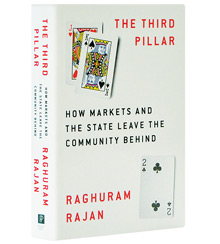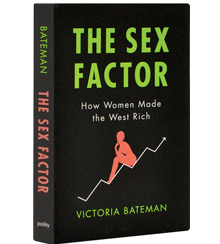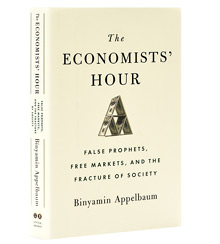Best Business Books 2019: Economics
Make economics germane again.
Raghuram Rajan
The Third Pillar: How Markets and the State Leave the Community Behind (Penguin Press, 2019)
Victoria Bateman
The Sex Factor: How Women Made the West Rich (Polity, 2019)
Binyamin Appelbaum
The Economists’ Hour: False Prophets, Free Markets, and the Fracture of Society (Little, Brown, 2019)
*A TOP SHELF PICK
Around the world, nationalism — of economic, ethnic, and other unpleasant flavors — is unmistakably on the rise. Just how much this trend owes to the economic trauma of the global financial crisis and its aftermath remains a subject of debate. But the shift in the political winds is pushing economics and economists to the margins of policymaking for the first time in decades. On the political right, parties once reliably supportive of economic orthodoxy have embraced restrictions on trade and immigration. Some on the left, in turn, are rediscovering a taste for state management of the economy, while cultivating an interest in heterodox schools of economic thought.
The trend leaves economists doubly chastened: by their failure to understand the economic forces helping to bring the world to this point, and by the resulting loss of influence they feel. In response, ever more members and observers of the profession, including the authors of this year’s best business books on economics, are asking themselves where exactly the field went wrong.
Few dismal scientists are as well positioned to critique the field as Raghuram Rajan. A respected scholar at the University of Chicago and a former head of the Reserve Bank of India, Rajan has a record of heretical but prescient criticism of his profession. In 2005, at a conference of economists and central bankers that celebrated the career of outgoing U.S. Federal Reserve chair Alan Greenspan, Rajan argued that financial innovation, of the sort many in the audience had cheered, was making the world a riskier place. In the wake of the ensuing crisis, he wrote Fault Lines: How Hidden Fractures Still Threaten the World Economy, which suggested that global economic woes were an inevitable consequence of divisions in society created by such factors as rising inequality.
In The Third Pillar, Rajan again chides the economics field for neglecting something important — and courting trouble in the process. The Third Pillar’s novelty begins with the title itself, which grants community a meaningful role in modern life in a way that is the norm in fields such as sociology but utterly alien in economics. The book is framed, unsurprisingly, around the worrying rise of formerly fringe political movements and nationalistic sentiments. To understand the wellsprings of these forces, he writes, we need to consider how some recent economic shifts have affected the economic geography of many countries. Globalization and technological change have, without question, generated substantial benefits. But these twin megatrends have also concentrated costs and localized economic devastation. This matters, he believes, because community is a critical part of the social infrastructure of a country. A community, which “anchors the individual in real human networks and gives them a sense of identity,” is where the rubber of abstract political and economic change meets the road of real life. It thus influences how people adapt to upheaval, or fail to.
Once, Rajan writes, the community was the dominant feature in social life; political and economic activity alike were rooted in local networks and institutions. This was often an unpleasant state of affairs: The all-encompassing communal institution of serfdom provided order, but at great human cost. Over time, though, states became both more powerful and more constrained by the rule of law. Technology allowed for greater economic possibilities — such as greater efficiency through specialization and trade — and for greater geographic and economic mobility. The real world became more like the frictionless, transactional economy idealized by economists. Community connections, after all, represent sand in the gears of economic efficiency. The more attached people are to a certain way of life, or to personal connections with friends and family, the less willing and able they are to adjust in the face of economic change. Too many economists reckon the real tragedy of a place like Detroit is the fact that some people are too fond of it to move elsewhere.
Rajan, in contrast, suggests that the benefits provided by community are worth the costs. Healthy communities help prepare their members for life in the world, by providing social instruction and opportunities for education and professional experience. They facilitate organization and collective action. They establish local schools or invest in deteriorating local infrastructure. And they help shape people’s identities, satisfying a need that might otherwise be met by demagogic politicians and radical movements.
The Third Pillar includes prescriptions for correcting the imbalance between community, on the one hand, and markets and the state, on the other. More political power could be devolved to local governments, for instance. But Rajan’s argument works best as a demand that economists recognize a critical blind spot. It is hard to believe that the world would not be a better place had economists and policymakers worried more about the effects of their preferred policies on vulnerable communities. If economists are to make themselves relevant again, they need to be able to offer insights of value on the role community plays in modern life.
The missing half
Blind spots often emerge in groups with too homogeneous a collection of perspectives. The many women and people of color pushed out of economics by hostile and discriminatory treatment represent brainpower that the field is failing to tap and ways of seeing the world that are not reflected in the research questions posed by economic scholars. The dismal science is slowly and belatedly recognizing that its lack of diversity has reduced the quality of research. But there is still plenty of room to drive the point home. The Sex Factor, by Victoria Bateman, does so in effective and enlightening fashion.
Bateman is an economic historian at the University of Cambridge known for her feminist views and, in Britain, for protesting the country’s decision to leave the European Union by delivering lectures on the subject while naked. In The Sex Factor she makes a very simple but compelling point. Most economic literature on the origins of industrialization and sustained economic growth is written as though half of humanity simply does not exist. It’s an omission that leads to a poorer understanding of how the world became rich.
The book opens with an informative overview of the leading explanations for why growth took off in the 18th century and why it began where it did. Most of these stories are not wrong, Bateman argues, merely incomplete. The security of property rights, the cost of important inputs to production such as coal and labor, and the emergence of a culture supportive of scientific inquiry and entrepreneurship unquestionably contributed to the outbreak of industrialization. But so did other factors. Women in northwest Europe were, on the eve of the Industrial Revolution, much less free and equal than Western women are today. But they nonetheless enjoyed critical advantages over women in other parts of the world, she writes, which helped pave the way for industrialization.
To go back even further, over the course of the Middle Ages, social rules for marriage and work had shifted in Europe in important ways. Marriages became more consensual, married couples tended to live on their own rather than in a communal home as part of an extended family, and women participated in commercial activity outside the home. The economic knock-on effects of these shifts were profound. Women got married and had children later in life. Couples’ need to build up a store of wealth to provide for a home helped create a pool of savings available to fuel domestic investment. Delayed childbearing also gave would-be parents more time to invest in their own human capital, and it reduced rates of fertility. Lower fertility, in turn, helped prop up incomes and increased the incentive and the resources available to invest in children’s human capital, through schooling or apprenticeship.
In these ways and others, Bateman argues, the liberating evolution of family roles and responsibilities in Europe, and in northwest Europe especially, prepared the region for its pathbreaking transition into modern economic growth. The value to economies of women’s liberation does not stop there. Greater freedom for women contributed to growth in the capacity of the state and the emergence of government-provided social safety nets, which have helped sustain red-blooded capitalism by softening its rougher edges.
On the other hand, Bateman notes, the overwhelming maleness of economics throughout the profession’s existence has sandbagged its efforts to comprehend the economy’s workings. Economists have neglected the importance of social and cultural influences on human behavior, and built their models with little recognition that people sometimes care about the welfare of others as well as their own. They instead have relied on a far more impoverished understanding of human action built on the assumption that people are mostly rational and self-interested. The message driven home by the book is that the health of both economics and global capitalism is intimately linked to the status and involvement of women.
Time’s up
At present, neither economics nor the global economy seems in fine fettle. In the year’s most compelling economics book, Binyamin Appelbaum, an economics columnist at the New York Times, explains why. The Economists’ Hour is a sweeping indictment of the intellectual contributions and policy victories of the field of economics over the past half century. Economists, he argues, have enjoyed an extraordinary period of sway over the shaping of public policy, which transformed the global economy and the societies of the developed world. That era is now coming to a bitter end, wrecked on the shores of
the profession’s hubris.
Time was, economists were viewed in the world’s great halls of power as little more than number crunchers, Appelbaum writes. In 1920, as the U.S. weighed whether or not to break up the industrial behemoth U.S. Steel, the Supreme Court snorted at testimony provided by an economist, calling it an inferior grade of evidence.
But as government control over the economy grew in the decades after the Great Depression and the Second World War, free market economists fought an intense rearguard campaign, building the intellectual case against government interventions. Intellectual heavyweights and Nobel Prize winners such as Milton Friedman and George Stigler helped create a movement of free market economists within academia while evangelizing their ideas outside it. Gradually, their view of the world won over converts in positions of power, a process that accelerated dramatically amid the economic turmoil of the 1970s, when growth slowed and inflation rocketed upward.
Appelbaum tackles cases in which the conventional wisdom has already turned against economists. One chapter recounts how the profession helped unleash the financial sector, freeing it from its post-Depression restraints. Few readers will need much persuading that the effects of excessive financial liberalization have been devastating, for both the world economy and the reputation of the profession. The book’s best chapters, however, take on policy shifts that most economists, and quite a few members of the public, still consider to be valuable.
Appelbaum looks, for example, at the way in which free market economic arguments were used to persuade Richard Nixon to abandon military conscription and rely instead on all-volunteer armed forces. Ditching the draft certainly feels like a win all around, especially for the vast numbers of young men in the U.S. not required to attend boot camp or face potential deployment, and the generals who value the commitment and training of career soldiers. But conscription had its benefits. The end of the draft is among the main reasons the sort of mass public opposition to war that characterized the Vietnam-era U.S. has been absent during the long campaigns in Iraq and Afghanistan. And although the most privileged members of society were always able to evade the draft, the sacrifices and hardships experienced by service members are now concentrated on a vastly smaller share of the population.
Or consider, more heretically still, Appelbaum on Fed chairman Paul Volcker’s monetary campaign against inflation in the late 1970s and early 1980s, which was built on the monetarist ideas of Friedman and his acolytes. The victorious battle to drive inflation down from double-digit rates is almost universally considered to have been a good thing, indeed an absolutely necessary one — not least by the people running the world’s big central banks today. But as Appelbaum notes, neither the economic return on reducing inflation or its absolute necessity is as clear as is conventionally assumed. The recessions triggered by Volcker’s monetary tightening caused mass unemployment, and joblessness is generally considered to be at least an order of magnitude more economically costly than inflation. Both the recessions and the accompanying rise in the dollar helped gut the country’s manufacturing sector, contributing to decades of pain for Rust Belt towns.
It is difficult to dispute Appelbaum’s overarching point: that the claims of the economists who helped overturn the policies of the postwar era have not been vindicated.
What is more, Appelbaum argues, inflation might have come down on its own in time. Inflation was in many ways the product of unique circumstances, among them the Vietnam War, a demographic bulge, a series of oil-price spikes, and an unexpected step down in productivity growth. Inflation trended downward in the 1980s and 1990s as these factors abated or flipped and became deflationary. But economists continue to tout the defeat of inflation as a win. The myth of the Volcker disinflation still thrives within central banks, contributing to an outlook that systematically underestimates the cost of unemployment and overestimates the risk of higher inflation — even as the world sinks, seemingly permanently, into a quagmire of near-zero interest rates and inflation.
It would be unfair to pin all the ills of this age on economists. Indeed, Appelbaum’s book would be stronger if he dwelled a bit more on the motives of the voters and politicians who embraced economists’ ideas, many of which had little to do with a desire for greater efficiency. But it is difficult to dispute Appelbaum’s overarching point: that the claims of the economists who helped overturn the policies of the postwar era have not been vindicated. Growth has not accelerated, deregulation has not brought about a surge in living standards, and a rising tide has not lifted all boats. In this new political climate, the reins are being pulled away from the hands of economists and technocrats. Economics might well manage to reinvent itself and regain its stature in the public eye. If and when that happens, however, the world may be a very different place.
Author profile:
- Ryan Avent is economics columnist at the Economist. He is the author of The Wealth of Humans: Work, Power, and Status in the 21st Century.








